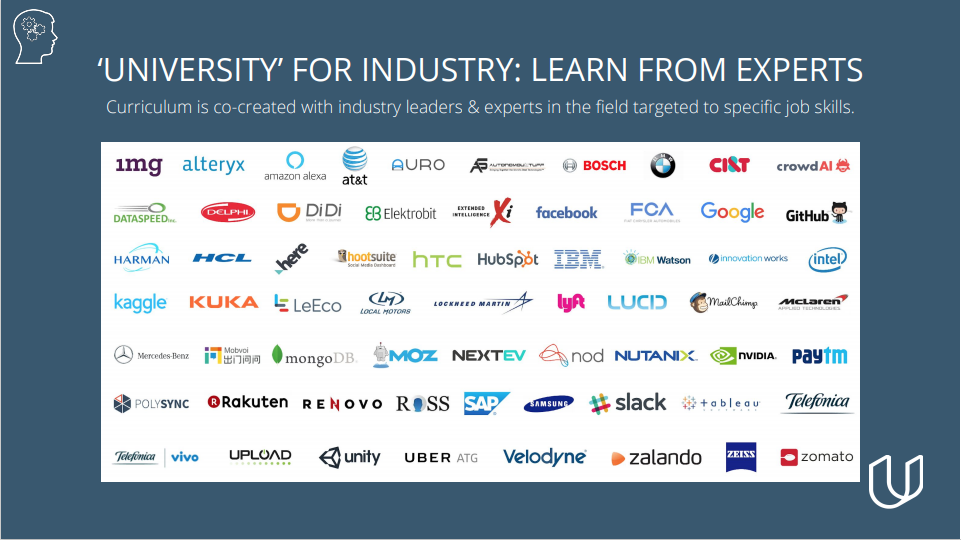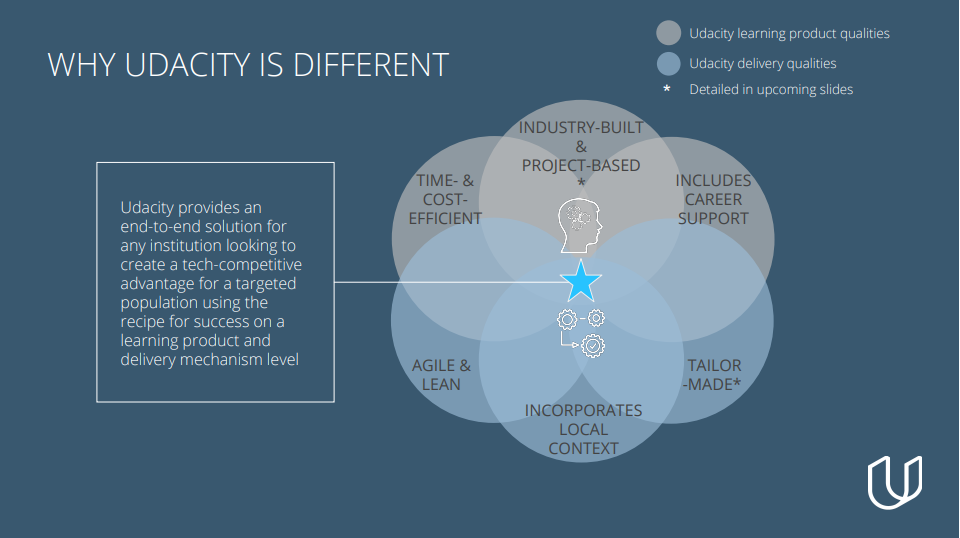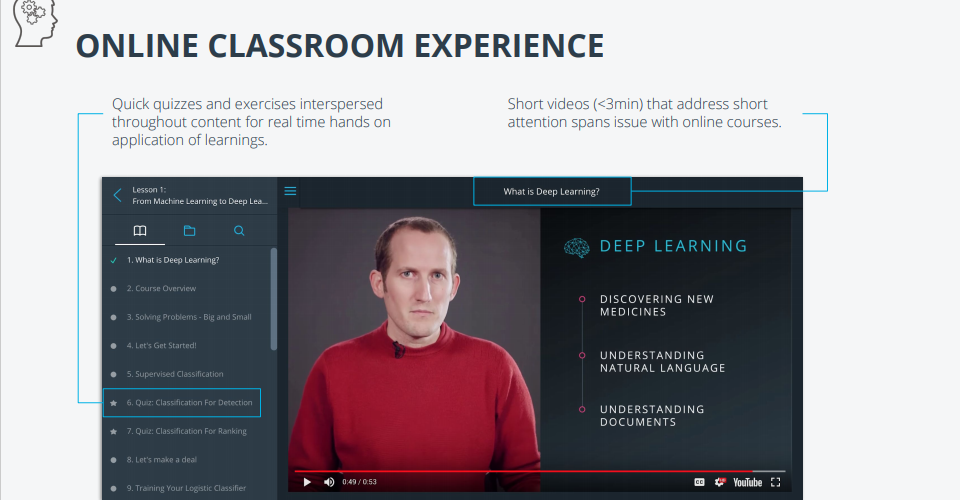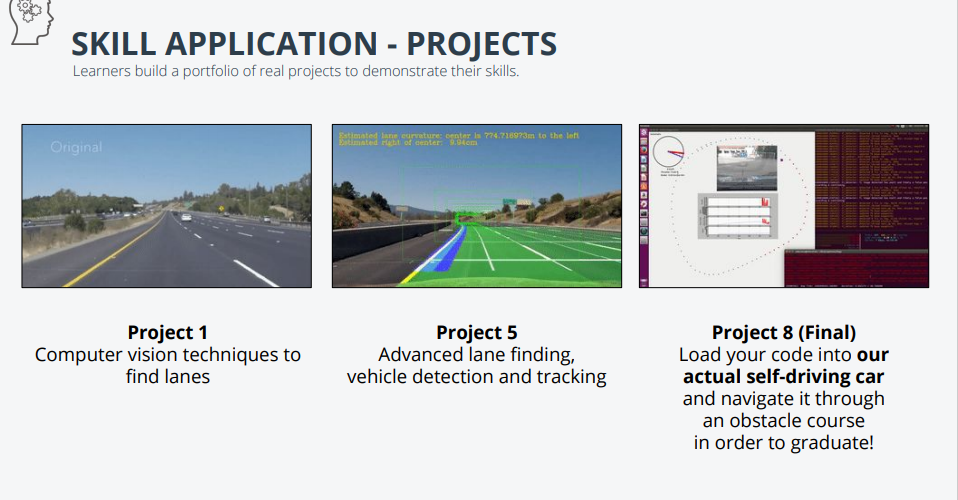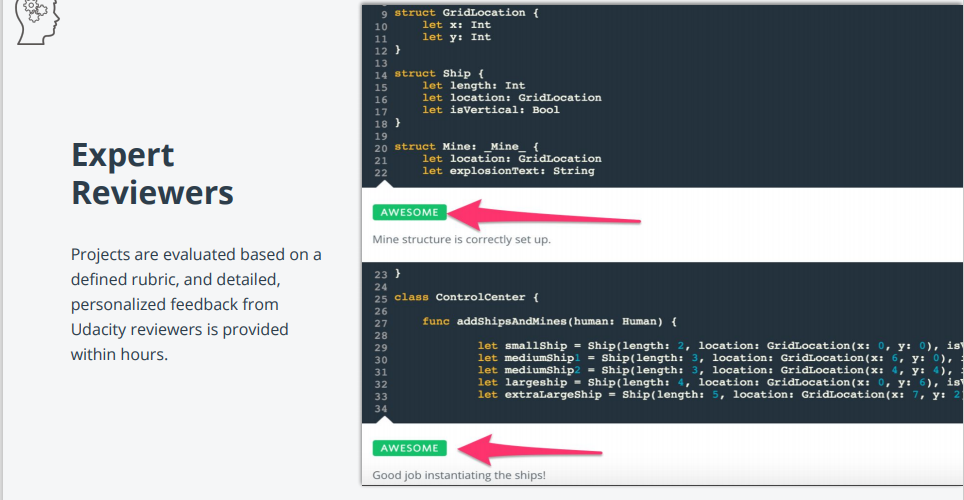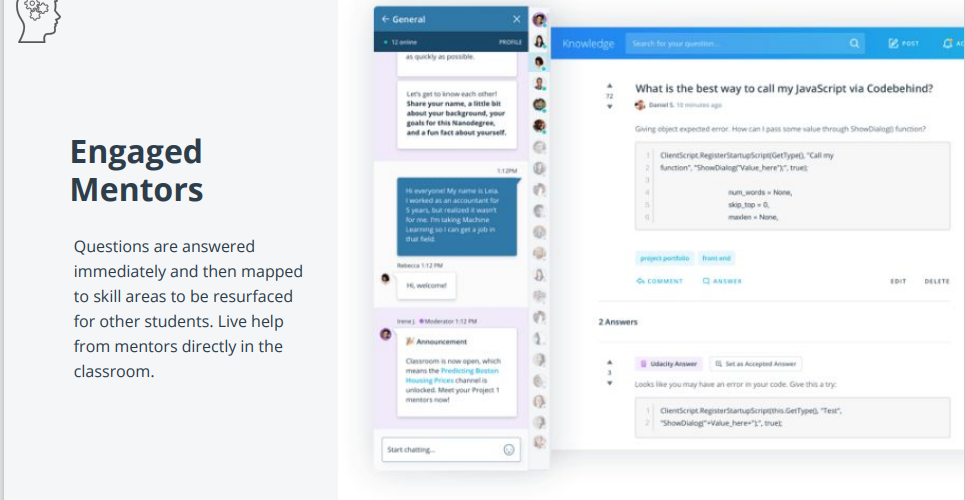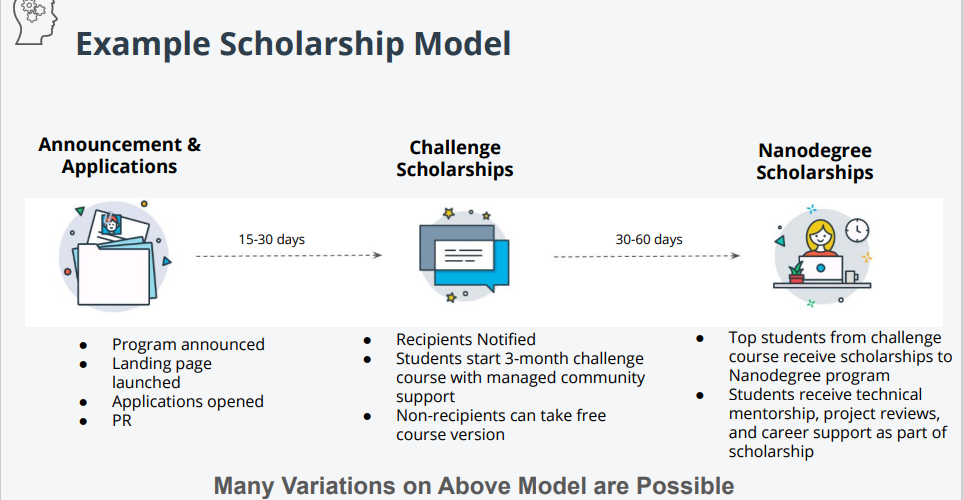”Work looks completely different today than it did just a generation ago. And most of the jobs we will have in 10 years haven’t been invented yet. Technological advancements in fields such as Data Science and Artificial Intelligence will have a significant impact on businesses across all industries. The pace of change has created a gap between the skills employees have right now and the skills they need to succeed. At Udacity, we believe that digital transformation and skills transformation go hand in hand. That’s why Udacity for Business offers a customized, end-to-end learning solution to bring your teams the proficiency and capabilities needed to compete and grow today Investing in lifelong learning is the most effective investment you can make today. The opportunity to empower employees to learn digital skills, cultivate innovation, and ultimately ensure that your workforce has a competitive advantage has never been greater. This is your chance to shape the future of your business!”
Innovative Online Education
Udacity’s mission is to empower people to learn the skills they need to shape the future. Our online learning platform offers accessible, innovative online education specializing in cutting-edge technologies and digital innovation.
Co-Created with Industry Leaders
Udacity works with industry leaders to create project-based online learning programs. These unique collaborations ensure that students learn relevant skills that correspond to actual needs in the market
Closing the Skills Gap
Focusing on fields such as Data Science, Machine Learning and Artificial Intelligence, our end-to-end solution helps you transform your workforce and close the skill gap.

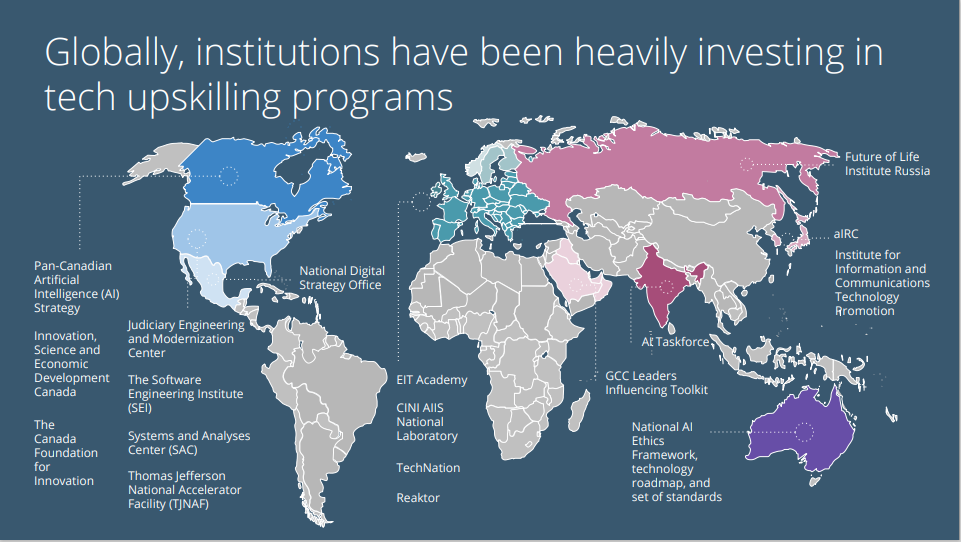
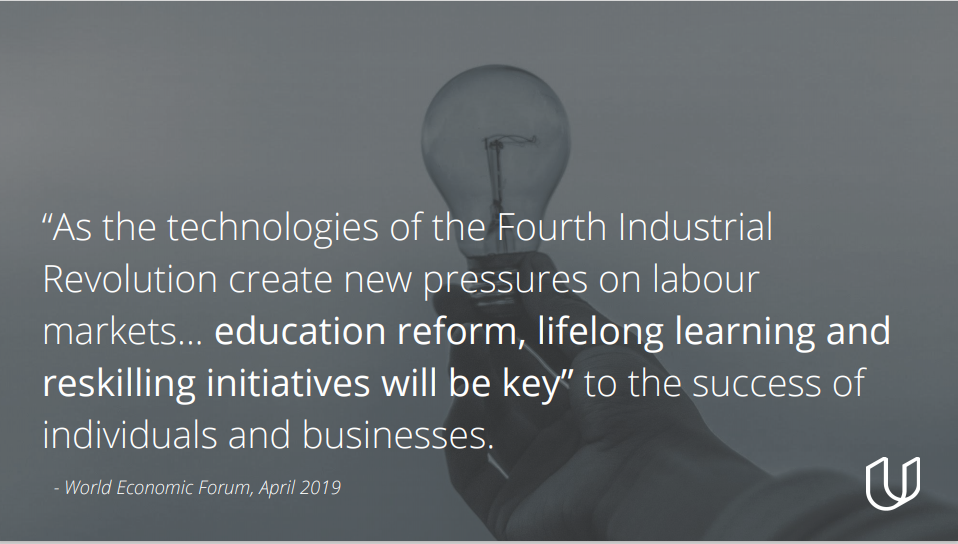
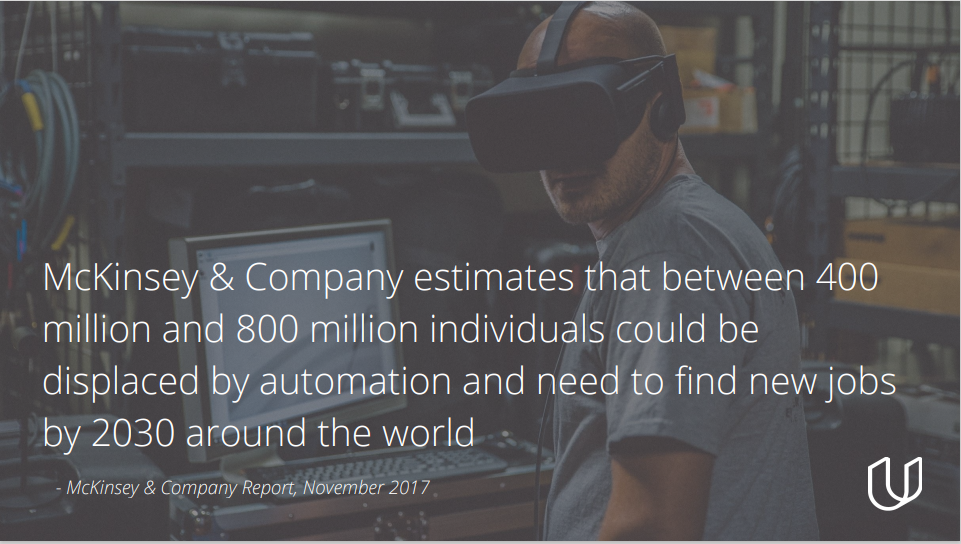
- VERY EXPENSIVE
On average 10,000-20,000 USD per student for 9-12 week coding bootcamps - LONG AND INFLEXIBLE
Average immersive in-person coding bootcamps demand a minimum of 12 weeks of daily physical presence from learners in specific locations - NOT SCALABLE
Capable of running < 200 student cohorts at a time, physically limited and not able to reach remote locations
- LOW COMPLETION RATES
Average graduation rate of MOOCs is typically 9-10% due to low engagement of programs - NOT ALWAYS PRACTICAL
Most online training involves watching passive videos and learning theory rather than including real-world practice
1)The right learning product
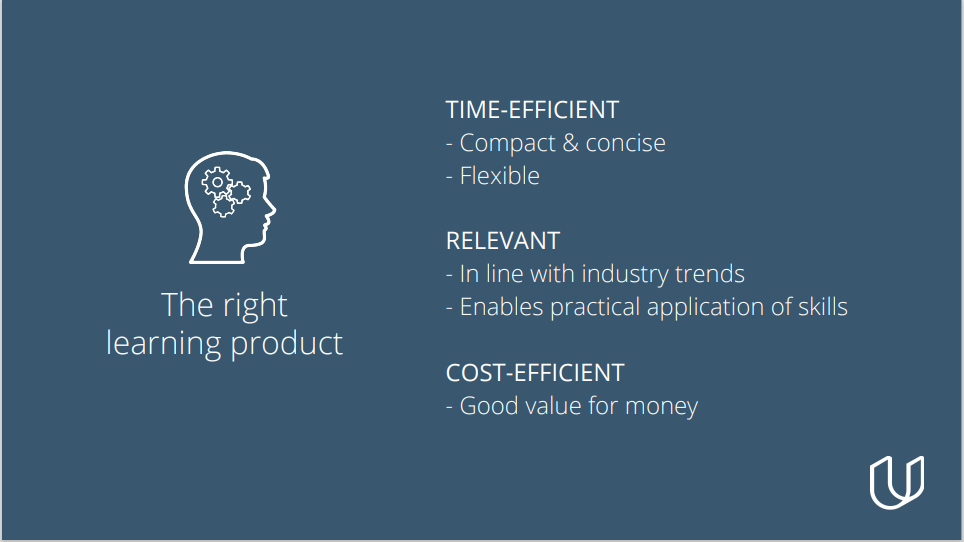
2)The right delivery mechanism

What is Udacity?
- Founded in 2011 by Sebastian Thrun.
- Online education through Nanodegrees co-developed with top tech companies.
- USD +1bln valuation in 2015
- #8 in NBC Top 50 tech disruptors in 2018.
- #19 in LinkedIn Top Tech companies in 2017.
- Currently, 40 +Nanodegrees available (3 – 6 months programs).
- 100k Nanodegree alumni globally, and >10 million users overall.
- Global presence including presence in USA, China, India, Europe and MENA.
❶ Sensor Fusion Engineer
❷ Self Driving Car Engineer
❸ Intro to Self-Driving Cars
❹ Robotics Software Engineer
❺ Flying Car and Autonomous Flight Engineer
❶ Data Structures and Algorithms
❷ Programming for Data Science
❸ Data Engineer
❹ Data Analyst
❺ Data Scientist
❶ Digital Marketing
❷ Business Analytics
❸ Predictive Analytics for Business
❹ Data Visualization
❺ Marketing Analytics
❶ Too Machine Learning❷ Machine Learning Engineer❸ AI Programming with Python❹ Deep Reinforcement Learning❺ Artificial Intelligence for Trading
❻ Computer Vision ❼ Natural Language Processing ❽ Deep Learning
❾ Artificial Intelligence
❶ Too Machine Learning❷ Machine Learning Engineer❸ AI Programming with Python❹ Deep Reinforcement Learning❺ Artificial Intelligence for Trading
❻ Computer Vision ❼ Natural Language Processing ❽ Deep Learning
❾ Artificial Intelligence
Bite-sized Online Modules
Short videos & interactive “learn by doing” exercises allow for training at scale.
Real-world projects
Employees build a portfolio of projects to demonstrate mastery of newly acquired skill sets.
One-On-One coaching
One-On-One Coaching, mentoring, and best-in-class, personalized project reviews.
1.Programming for Data Science with R
General Information
In this program, learners will understand how to manipulate large datasets, perform version control, and access modern databases. Specifically, we will focus on:
Project Examples
Investigate a Database–Work with a relational database – specifically PostgreSQL. Complete the entire data analysis process, starting by posing a question, running appropriate SQL queries to answer a question, and finishing by sharing the findings.
Explore US Bikeshare Data–Use R to answer analytical questions about bikeshare trip data collected from three US cities. Write code to collect the data, compute descriptive statistics, and create an interactive experience in the terminal that presents the answers to a question.
Post your work on GitHub– Learn version control by using github from the terminal. Post two different versions of a Jupyter Notebook capturing learnings from the course, and add commits to the project Git repository.
Outcome
Upon course completion learners will have obtained knowledge of the most valuable programming tools and languages used by data scientists today.
Time
● 3 Months
● Study 10 hrs/week
Prerequisites
● None
Built in partnership with
● Mode
Software needed
● Robot Operating System,
● Gazebo, Nvidia Jatson TX2
Difficulty
● Foundational
Interested in this program?
Learn more
2.Programming for Data Science with Python
General Information
In this program, learners will better understand how to evaluate the business value of an AI product. Specifically, we will focus on:
Project Examples
Find Donors for CharityML –CharityML is a fictitious charity organization established to provide financial support for people eager to understand machine learning. Evaluate and optimize several different supervised learners to determine which algorithm that maximizes donation yield while minimizing the total number of letters being sent to ask for donations.
Create an Image Classifier – Implement an image classification application using a deep learning model on a dataset of images. Use the trained model to classify new images.
Create Customer Segments – Use unsupervised learning techniques to segment customers into distinct categories using various clustering techniques. This segmentation is used to help the business make more informed marketing and product decisions.
Outcome
Upon course completion learners will understand data cleaning and supervised models, as well as deep and unsupervised learning.
Time
● 3 Months
● Study 10 hrs/week
Prerequisites
● None
Built in partnership with
● Mode
Software needed
● Robot Operating System,
● Gazebo, Nvidia Jatson TX2
Difficulty
● Foundational
Interested in this program?
Learn more
1.Intro to Machine Learning
General Information
In this program, learners will better understand how to evaluate the business value of an AI product. Specifically, we will focus on:
Project Examples
Find Donors for CharityML –CharityML is a fictitious charity organization established to provide financial support for people eager to understand machine learning. Evaluate and optimize several different supervised learners to determine which algorithm that maximizes donation yield while minimizing the total number of letters being sent to ask for donations.
Create an Image Classifier – Implement an image classification application using a deep learning model on a dataset of images. Use the trained model to classify new images.
Create Customer Segments – Use unsupervised learning techniques to segment customers into distinct categories using various clustering techniques. This segmentation is used to help the business make more informed marketing and product decisions.
Outcome
Upon course completion learners will understand data cleaning and supervised models, as well as deep and unsupervised learning.
Time
● 3 Months
● Study 10 hrs/week
Prerequisites
● Intermediate Python
● programming knowledge and
basic knowledge of probability
and statistics
Built in partnership with
● Kaggle & AWS
Software needed
● None
Difficulty
● Foundational
Interested in this program?
Learn more
2.AI Programming with Python
General Information
In this program, learners will better understand how to evaluate the business value of an AI product. Specifically, we will focus on:
- ● Introduction to Python
- ● Linear Algebra Essentials
- ● Calculus Essentials
- ● Neural Networks
- ● Jupyter Notebooks, NumPy, Anaconda, Pandas, and Matplotlib
Use a Pre-trained Image Classifier to Identify Dog Breeds –Test Python skills by working with three different pre-trained image classifiers. Write a script to identify different dog breeds.
Mini Projects – Use NumPy to mean normalize an ndarray and separate it into several smaller ndarrays. Use Pandas to plot and get statistics from stock data.
Create an Image Classifier – Create an image classifier application. Build a neural network and identify objects appearing in images, just as humans do.
Outcome
Upon course completion learners will be able to deploy machine learning models into production.
Time
● 3 Months
● Study 10 hrs/week
Prerequisites
● Basic algebra and
programming knowledge
basic knowledge of probability
Software needed
● None
Difficulty
● Foundational
Interested in this program?
Learn more
1.Intro to Programming
General Information
In this program, learners will learn the foundational skills all programmers use to create mobile apps or web pages, or to analyze data. Specifically, we will focus on:
Project Examples
Animal Trading Cards –– Create a trading card for a favorite animal. Utilize HTML knowledge to create the structure for the trading card. Use CSS styling to design the card.
Rock, Paper, Scissors – Create an interactive game in Python by using object-oriented programming to affirm key understanding of programming logic and functions and fundamental problem solving skills. skills.
Pixel Art Maker – Build a single-page web app that allows users to draw pixel art on a customizable canvas
Outcome
Upon course completion learners will develop a strong foundation in fundamental programming concepts.
Time
● 4 Months
● Study 10 hrs/week
Prerequisites
● Basic algebra and
programming knowledge
Software needed
● Python 3, a code/text editor, a
web browser, a command line
editor
Difficulty
● Foundational
Interested in this program?
Learn more
2.Android Basics
General Information
We built this curriculum with Google for aspiring Android developers who are new to programming to ensure learners receive real-world skills they need to start building apps. Specifically, this program focuses on:
- ● Android Basics: user interface & user input
- ● How to show multiple screens, and add audio and images to an app
Project Examples
Scorekeeper App –Implement an app to track scores between two teams playing a game.
Quiz App – – Design and implement a short quiz app about a familiar topic.
Musical Structure App – Architect the user experience and technical design of an app to play music for a user.
Tour Guide App –Create an app to guide a user around a city or location of your choice!
News App –Create a News feed app using an API that gives a user regularly-updated news from the internet related to a particular topic, person, or location. The presentation of the information and the topic can be personalized by the learner.
Outcome
Upon course completion learners will be prepared to build apps and accelerate their journey towards becoming a professional Android Developer.
Time
● 3 Months
● Study 10 hrs/week
Prerequisites
● None
Built in partnership with
● Google
Software needed
● None
Difficulty
● Foundational
Interested in this program?
Learn more
3.Data Structures and Algorithms
General Information
In this program, learners will gain comprehensive knowledge of data structures and algorithms by solving 100+ practice problems. Specifically, we will focus on:
Project Examples
Unscramble Computer Science Problems – Deconstruct a series of open-ended problems into smaller components (e.g, inputs, outputs, series of functions).
Show Me the Data Structures – Solve a series of open-ended practice problems such as LRU Cache, Private Blockchain, File Recursion, and many more.
Problems vs. Algorithms – A series of real-world open-ended problems, such as request routing for a web server, search-term auto-completion and Fibonacci heap.
Tour Guide App –Create an app to guide a user around a city or location of your choice!
Route Planner – Build a route-planning algorithm like the one used in Google Maps to calculate the shortest path between two points on a map. Select and implement appropriate data-structure to represent points on a map and then implement A* algorithm to find the shortest path.
Outcome
Upon course completion learners will be able to evaluate and assess different data structures and algorithms for any open ended problem and implement a solution based on design choice.
Time
● 4 Months
● Study 10 hrs/week
Prerequisites
● Python & basic algebra
Built in partnership with
● None
Software needed
● None
Difficulty
● Practitioner
Interested in this program?
Learn more
4.Front End Web Developer
General Information
The Front End Web Developer Nanodegree program is right for employees who want to design and build next-generation front-end interfaces for the web. Specifically, this program focuses on:
- ● Web accessibility
- ● Object-oriented JavaScript
- ● JavaScript tools & testing
- ● Front-end applications
Project Examples
Memory Game – Build your own version of the classic memory game ‘Concentration’, using JavaScript, DOM selectors, event listeners and CSS styling to create and design a trading card for a favorite animal.
Restaurant Reviews – Convert a static webpage to a mobile-ready web application. Take a static design that lacks accessibility and convert the design to be responsive on different sized displays and accessible for screen reader use. Begin converting this to a Progressive Web Application by caching some assets for offline use.
Outcome
Upon course completion learners with key skills that enable them to build HTML, CSS, and JavaScript components/pages and interact closely with back-end developers.
Time
● 4 Months
● Study 10 hrs/week
Prerequisites
● Basic HTML, CSS and JavaScript
Built in partnership with
● AT&T, Google, GitHub
Software needed
● None
Difficulty
● Practitioner
Interested in this program?
Learn more
5.Full Stack Web Developer
General Information
The Full-Stack Web Developer Training Program is ideal for learners who have a solid grounding in HTML, CSS, and Javascript and want to add back-end expertise to their front-end development skills. Specifically, this program focuses on:
- Building complex server-side web applications
- Develop complex relational databases
- Secure and configure your own Linux-based servers
Project Examples
Logs Analysis – Analyze data from the logs of a web service to answer questions such as ”What is the most popular page?” and ”When was the error rate high?” using advanced SQL queries.
Item Catalogue- Develop an application that provides a list of items within a variety of categories, as well as provide a user registration and authentication system. Registered users will have the ability to post, edit, and delete their own items.
Outcome
Upon course completion learners will be able to build and manage relational databases to store and handle application data, and build powerful server-side applications to serve that data to any type of client-side application.
Time
● 4 Months
● Study 10 hrs/week
Prerequisites
● HTML, CSS, and JavaScript
Built in partnership with
●AT&T, Google, GitHub, AWS
Software needed
● None
Difficulty
● Practitioner
Interested in this program?
Learn more


